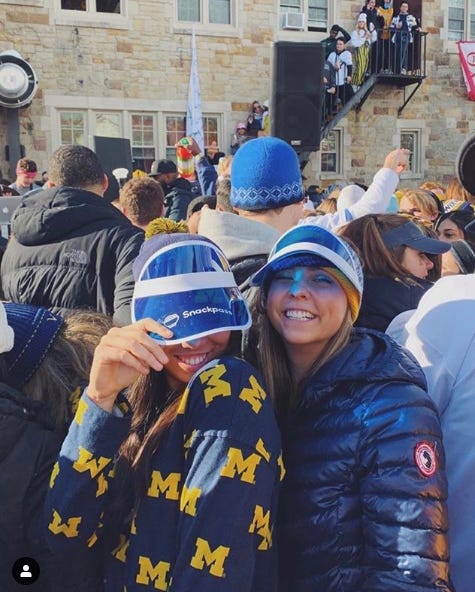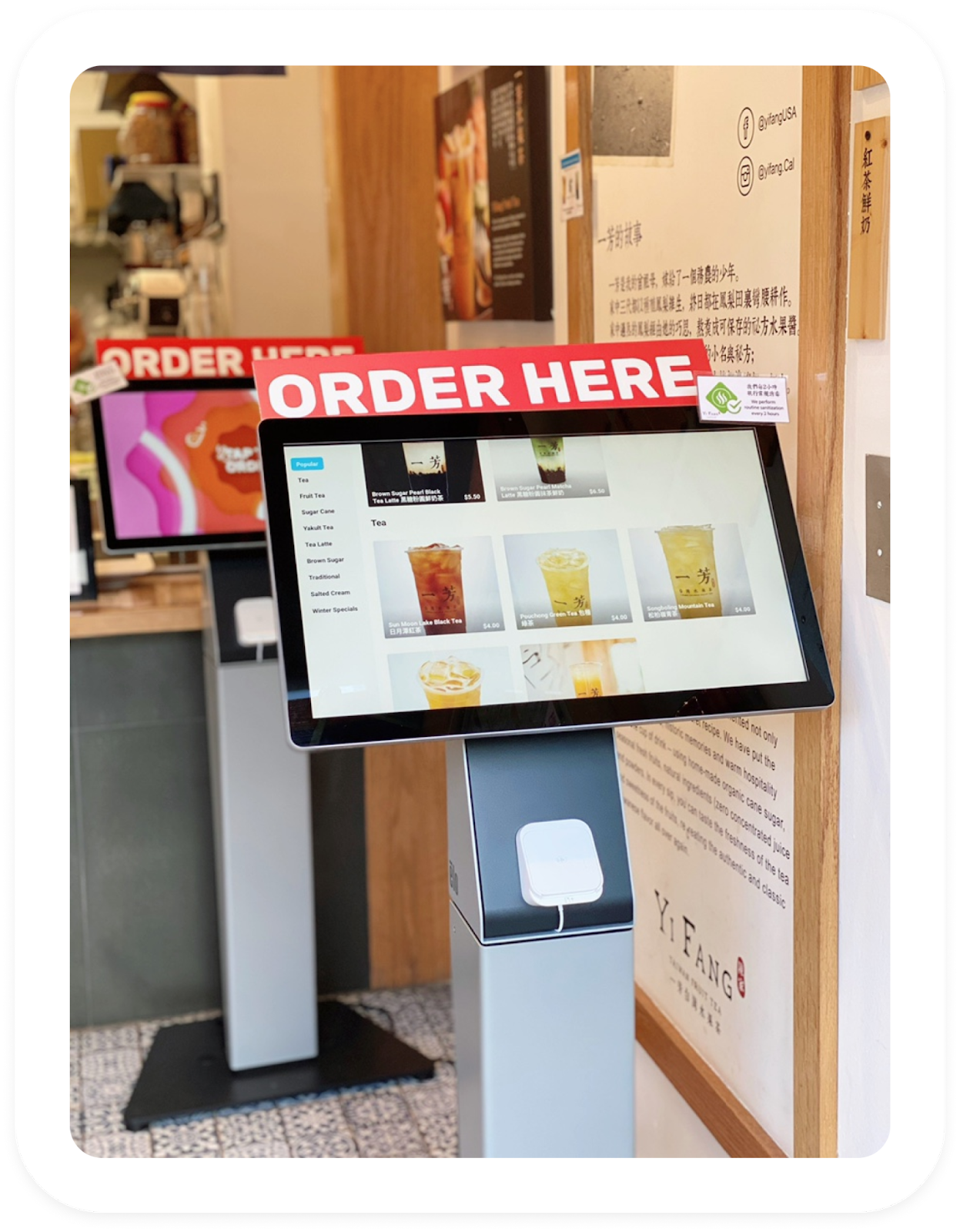.
🚗 Snackpass’s Journey – Early Days
These two pain points led him to an idea for a food discount app – if his college economics class taught him anything, it was that price discrimination through discounts can be an effective tool to bring more orders, especially at a college campus like Yale. To turn his idea into reality, he also brought on board two co-founders, Jamie and Jonathan.
Making a splash with MVP 💦
After coming up with the idea, Kevin and his team went door-to-door to talk to restaurant owners. The goal was to learn more about their needs while building a relationship. With some pilot restaurants, he quickly launched the MVP during his senior year at Yale.
It was a simple app for local restaurants to offer discounts and loyalty points to Yale students who order pick-up with their .edu account. For Yale students, Snackpass was a great way to save money and avoid the line. For restaurants, Snackpass allowed them to tap into the entire Yale campus and serve more people.
The MVP was an instant hit at Yale, quickly penetrating over 80% of the Yale campus.
The feature that fueled this early flywheel? Gifting.
Gifting changed the game 🎁
Gifting was a game-changer – people could send food and reward points to their friends on Snackpass. This feature was unique at the time because most food apps did not emphasize this type of social behavior. Funny enough, it was a product decision that came from Kevin’s attempt to flirt with a girl 👀.
“At the time, there was this girl I was trying to impress. Her favorite smoothie place was Tropical Smoothie. I thought it would be quite a gesture if I sent her a gift on the app and everyone could see it. It just clicked.”

Gifting became a special language for Snackpass, similar to Facebook’s poke feature in the early days. People could use it to flirt with each other and bond with friends. Restaurants also loved this feature because it was great marketing. Snackpass has slowly built a network effect through gifting and other social features, differentiating itself within this crowded and highly fragmented food space.
Eating is an inherently social activity, and gifting being at the core of the Snackpass product brought back that social fabric to food ordering that has been overlooked by the plethora of competitors in the food ordering space. Snackpass’s edge, aka the fuel to their growth, is taking what was a logistic/efficiency play (ordering food) and turning it on its head to a social/fun one.

Unusual North Star 🌟
Social features like gifting are what make Snackpass truly special. They are possible due to the unique DNA of the team. Internally, Snackpass has a North Star – if a feature makes them laugh, they will put it in. One of those features is Valentine’s Day puns 💝.
“On Valentine’s Day, we added puns to all the food items people were gifting. If it was a berry smoothie, we would say ‘I love you berry much’. My favorite one was the pun for drunken noodles, for which we added ‘I’m drunken in love’. We attached these puns to the gifts and this feature became a big hit.”
Another fun one is the chicken feature. You can hatch an egg and get virtual chicken with your friends on Snackpass by accumulating enough points from a specific restaurant. It can even be addictive, similar to the streak feature on Snapchat.
Getting their first 10,000 customers 🔥
#1 – Create an amazing product
Although it sounds cliche, the most important factor of Snackpass’s rapid growth is still its delightful product experience. It solves problems for both consumers and restaurants, and as a result, people tell their friends. When it first launched at Yale, Snacks took over 80% of the campus within one semester and most Yale students used it at least once a week or more.
Kevin and his team were so inundated with orders that they would go to restaurants and help them wash dishes and blenders so restaurants could keep taking on orders.
#2 – Establish a college ambassador program
Kevin and his team adopted the growth playbook used by Facebook and Tinder by building a college ambassador program. They experimented with it by hiring over 60 brand ambassadors all over New Haven to supercharge the growth. They tried many different angles, from partnering with sororities, athletic teams, to campus groups, and they gave away tons of free gifts, merchandise for people to try out the app.
They wrote down all the key learnings in a Google doc and created a replicable playbook for other campuses. This program helped them to grow to 10 campuses, achieving over $10M in GMV and 25% month-over-month growth by 2019 – accomplishing all with 8 employees.

Riding on a bumpy road 🚴♂️
It was not all rosy during this early hyper-growth period. In fact, they had several near-death experiences. One of them happened right before the Berkeley launch. They spent over $30K on new tablets for restaurants to track orders. However, all of them turned out to be faulty.
“Restaurants told us the tablets were pressing on their own. We were coding non-stop, day and night, trying to fix the issue. We were trying to get all things done before we launched at Berkeley in a week since we made all these promises to those restaurants. We had to pull it off.”
📱Next chapter – leading the cashierless transformation
For the first part of the journey, Kevin and his team honed in on the user experience for customers and restaurants while doubling down on the college food takeout market. The result of this focus is obvious. People love using Snackpass. An average user uses the app once or twice a week and a power user uses it daily or even multiple times a day. As Jeff Fluhr from Craft ventures puts it:
“Snackpass has achieved the holy grail — a transactional commerce product that is social, viral, and fun. Its marketplace has strong network effects and a compelling value proposition for both consumers and restaurants.”
Kevin’s vision 🚀
Kevin’s vision for Snackpass is to dominate the food takeout market and lead the charge in cashierless transformation, helping restaurants go digital.
“I think there are going to be some inevitable shifts in the restaurant industry. All in-store purchases will transition from credit cards to digital. A restaurant pays a minimum of $7000 a month for their POS and cashiers just so they can accept credit cards, but everyone should be able to self-checkout on their phones or other smart devices.”
The next chapter is about ramping up the effort to go beyond college campuses and to supercharge restaurants, empowering them to create a better ordering experience for their customers.
Three products will become the backbone of this strategy – digital menu, self-service kiosk, CRM tools.
#1 – Digital Menu
Even though COVID has slowed down many restaurant businesses, it has accelerated the adoption of in-store mobile payment. To help restaurants during this pandemic, Snackpass launched a new product called digital menu – customers can view and order from menus on their phone browsers, scanned from QR codes outside the restaurant and inside the restaurant for contactless transactions.
I believe this consumer behavior is going to continue as more consumers and restaurants start to realize how efficient digital menus are. This behavior is not new in many Asian countries. According to a recent survey, “74 percent of Chinese consumers make mobile payments daily and QR codes are leveraged for a staggering 95 percent of these transactions.”

#2 – Self-service kiosk
The second part of the puzzle is the self-service kiosk. The kiosk is like a smart, smart employee that never takes a break. Not only does it save thousands of dollars in labor cost for restaurants every month, but the kiosk can also automatically upsell customers and collect purchase analytics data. With the help from kiosks, restaurant workers can be “freed up to create food and service rather than punch in orders”.
Self-service kiosks will unlikely be implemented in most sit-down restaurants since consumers are likely more interested in a proper dining experience when going to those restaurants, but I predict that, in the next three years, it will likely gain a strong adoption in most fast-food chains and coffee & boba shops that want to increase capacity and throughput rate.

#3 – CRM tools
The secret sauce of Snackpass’s success so far is its deep commitment to restaurant operators. From the very beginning, Kevin and his team have been laser-focused on building tools and assets that supercharge restaurants.
They charge restaurants a 7% commission for mobile orders which is 4x lower than Uber Eats and other delivery players. Moreover, instead of blocking the relationship between restaurants and customers, Snackpass facilitates that valuable relationship through its CRM tools. For example, restaurants can access all the customer data through Snackpass’s analytics dashboard and launch customizable promotional campaigns and automated retention emails to bring their customers back.
“Restaurants are brands with local followings, not commodities. We give merchants tools to grow and engage their customer base and convert offline, anonymous in-store traffic into digital followers.”

The road ahead 🛣
Snackpass has killed it in recent years, especially during the pandemic. They are the largest social commerce platform in the US with 500K+ customers, amassing over $60M a year in sales volume. It has gained the approval stamps from the valley – to date, Snackpass has raised over $92M from top institutional investors, including Andreessen Horowitz (led by Andrew Chen), Craft Ventures, General Catalyst, First Round Capital, and Y Combinator.
As Snackpass ventures beyond the wholesome college market into cities, the road ahead will not be easy, or perhaps even treacherous. Kevin and his team will face the pains of growing up – How to retain college students after they graduate? How to hire the best people and maintain a playful culture? How to prioritize which markets to tackle? It is unclear where Snackpass will stand at the end of the day, but I have a feeling it is here to stay.












